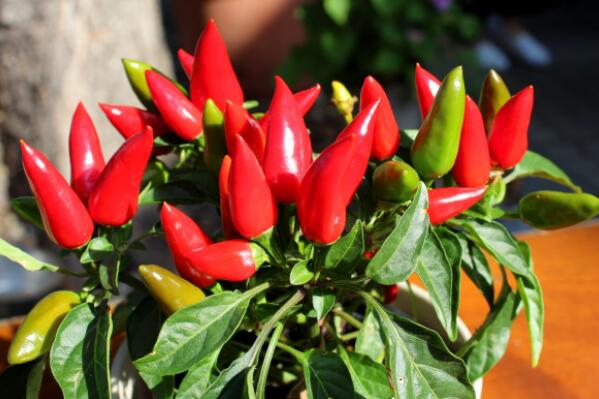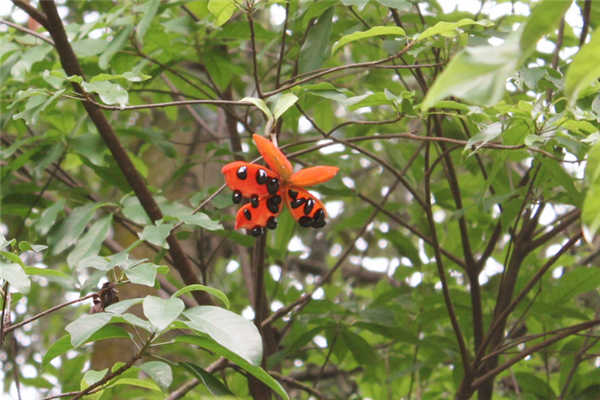Planting flowers is not as good as growing chili peppers: potted ornamental pepper varieties and planting techniques!
Many friends who live in the city like to plant some flowers and vegetables on the balcony, which can purify the air, beautify the indoor environment and be edible. And growing flowers and vegetables must not miss potted chili peppers, now there are a lot of potted ornamental chili peppers, not only delicious but also good-looking, far looks like a pot of flowers. The following is to introduce several varieties of ornamental chili peppers suitable for potted plants and the key points of planting techniques.

1. Nebula fruit chili
It is horn-shaped, the fruit is about 5 cm long, the single fruit weighs 25 grams, the fruit shape is exquisite, the size is the same as the common pepper, it belongs to a kind of sweet pepper, and the fruit color changes from light green to red when ripe. Fruit chili peppers are crisp, sweet and juicy, suitable for eating raw and ready to eat. As rich in a variety of vitamins, especially vitamin C content as high as 180 mg / 100 g, for the prevention and treatment of oral ulcers have a better effect. The plant type is relatively tall, and the single plant is suitable for flowerpot cultivation with a diameter of more than 35 cm.
Second, wind bell pepper
The shape of the fruit is like the wind chime, the fruit length is about 4 cm, the top width of the fruit is about 5 cm, the taste is spicy; the tender fruit is bright green, it turns bright red after maturity, the fruit is late, and it belongs to the late-maturing variety; the plant type opens, the plant height is 50 cm, and there are 30-40 fruits per plant. Single plant is suitable for flowerpot cultivation with a diameter of about 35 cm.
Third, Chaotian colorful pepper
The fruit grows upward, showing a narrow, twisted little finger shape, 4-6 cm long and 1 cm wide, slightly spicy, milky white at the beginning, gradually yellow, then orange-red, and finally red, a single plant can appear several colors of fruit at the same time, the whole plant is torch-shaped when full red. The plant type is short, natural and compact, with a plant height of about 20 cm and a plant width of 20-25 cm, with 40-50 fruit per plant. Single plant is suitable for flowerpot cultivation with a diameter of about 15 cm.
Fourth, rice pepper
The fruit is the size of a grain of rice, and its young fruit is milky white, hence the name. The plant height is about 25 cm, the branch is many, the fruit is many, the fruit is oblate, the fruit diameter is about 0.5 cm, the taste is spicy. In the process of fruit growth, there are white, purple, red and other changes. The fruit grows upward and is more shady. The plant type is small and suitable for flowerpot cultivation with a diameter of about 25 cm.
Then, once you have selected the variety to be planted, you have to know how to plant it to make it look good and prolific.
The main results are as follows: 1. Ornamental pepper has a long seedling stage, which is suitable for seedling raising and transplanting. In order to ensure that the seedlings are uniform and strong, the seeds can be soaked in warm soup and germinated before sowing.
2. Put the seeds in a cup and other containers, first pour a little cold water, soak the seeds for about 3-5 minutes, wait for the seed skin to soak and absorb some water, slowly pour hot water into the container, pour while stirring, so that the seeds are heated evenly, so as not to burn the seeds. When the water temperature in the container rises to 53 ℃-55 ℃, the heating can be stopped. When the temperature drops, add less hot water to keep the water temperature at the required temperature. Keep it this way for 10 minutes, then set it aside and let it cool to 20 ℃-30 ℃.
3. The seeds after soaking are washed with clean water, then wrapped with clean wet gauze or wet towels, placed in a 25 ℃-30 ℃ air permeable place to promote germination, and rinse the seeds with warm water every 12 hours. Generally, white seeds can be seen after two or three days, and when the proportion is more than 50%, you can sow and raise seedlings.
4. Because of the long seedling stage, some organic fertilizers are needed in the seedling soil. Organic fertilizers must be fully mature, and other nutritious soils should be sun-dried, which can effectively avoid and reduce the sources of diseases and insect pests. It is recommended to use pastoral soil (preferably those that have not grown eggplant, tomato or pepper) and a mixture of nutritious soil and organic fertilizer purchased in the market. Peat soil + pastoral soil + vermiculite + perlite + organic fertilizer is ideal in accordance with the volume ratio of 4 to 2. Mix the soil and fertilizer evenly, and then load the seedling bowl. Household disposable paper cups are more suitable to be used as seedling bowls.
5. Pour water into the seedling bowl before sowing. After the water permeates, place a seed in the center of each bowl to promote budding, then cover it with a layer of fine soil about 0.5 cm thick, gently compacted and sprinkled with water. After sowing, the bowl can be covered with transparent thin plastic or newspaper with holes, which can not only moisturize, but also ensure sufficient oxygen; remove the cover in time after emergence.
6. Ornamental peppers prefer light at seedling stage, so they need sufficient light; pay attention to shading or move indoors to prevent sunburn and fruit drop during the full fruit period. It is also necessary to keep the soil fertile and soft. Topdressing can be foliar sprayed with 0.5% potassium dihydrogen phosphate solution 2-3 times during the fruiting period. Watering is better in the morning and evening.
7. to maintain good ventilation, pick old yellow leaves and poorly grown side branches. To prevent insect pests, 2000-4000 times of thiazide water dispersible granules can be used to irrigate the seedling bowl; a small amount of whiteflies and aphids can also be brushed off with a brush and sprayed with clean water.
Time: 2019-04-11 Click:
- Prev

What is the nutritional value of avocado how to eat avocado?
General fruits are high in calories, but this kind of fat contained in avocados is a high-quality fat that the human body needs very much. at the same time, it is also rich in a variety of vitamins and minerals such as sodium, potassium, magnesium and calcium, and the dietary fiber content is also very high. so people with constipation eat avocado properly. Step 8, another piece is also covered with avocado, covered on eggs, diagonally cut 2 knives, X this shape. Step 9. How does butter eat toast and bread? how does avocado taste? how does avocado taste? how does avocado eat toast and bread?
- Next

How to grow sterculia? When is it ripe for harvest?
Sterculia chinensis is a common garden tree and street tree in the south of Guangdong Province with dense crown, evergreen leaves and beautiful tree shape. Its fruit has a high edible value, can be steamed, boiled, appropriate roast, molasses and braised, deeply loved. so
Related
- Fuxing push coffee new agricultural production and marketing class: lack of small-scale processing plants
- Jujube rice field leisure farm deep ploughing Yilan for five years to create a space for organic food and play
- Nongyu Farm-A trial of organic papaya for brave women with advanced technology
- Four points for attention in the prevention and control of diseases and insect pests of edible fungi
- How to add nutrient solution to Edible Fungi
- Is there any good way to control edible fungus mites?
- Open Inoculation Technology of Edible Fungi
- Is there any clever way to use fertilizer for edible fungus in winter?
- What agents are used to kill the pathogens of edible fungi in the mushroom shed?
- Rapid drying of Edible Fungi

